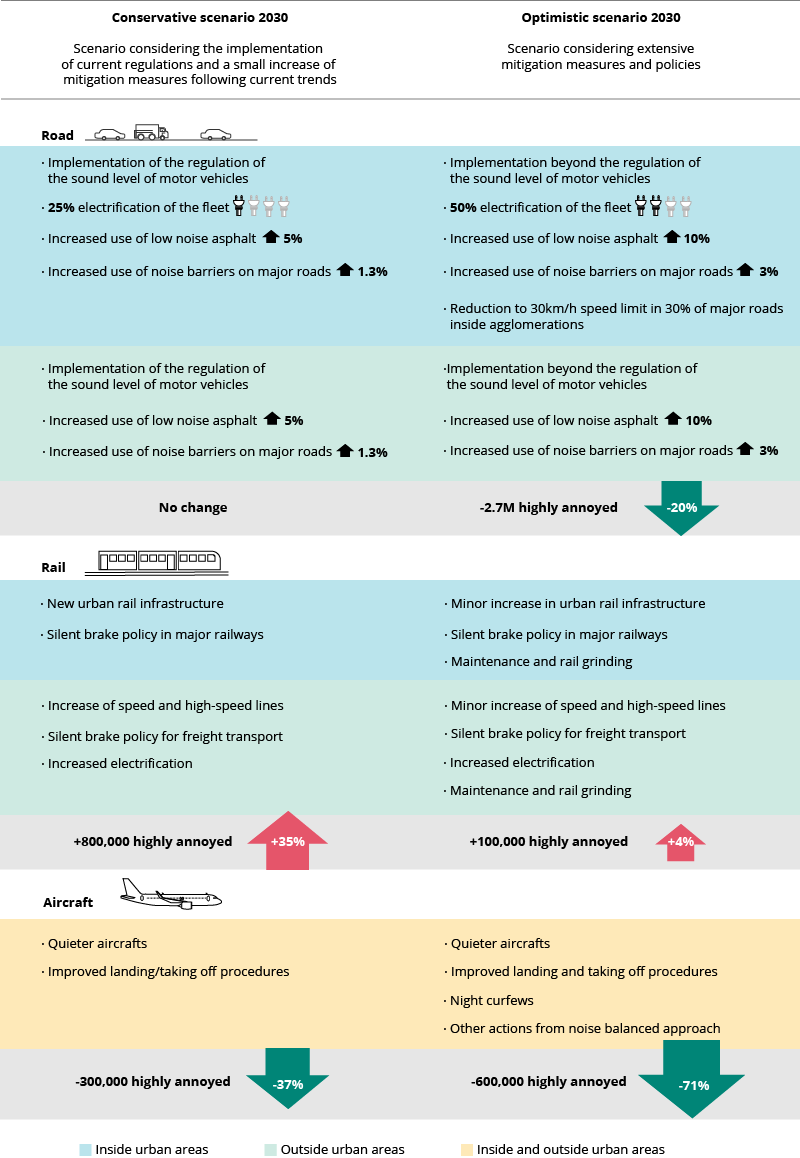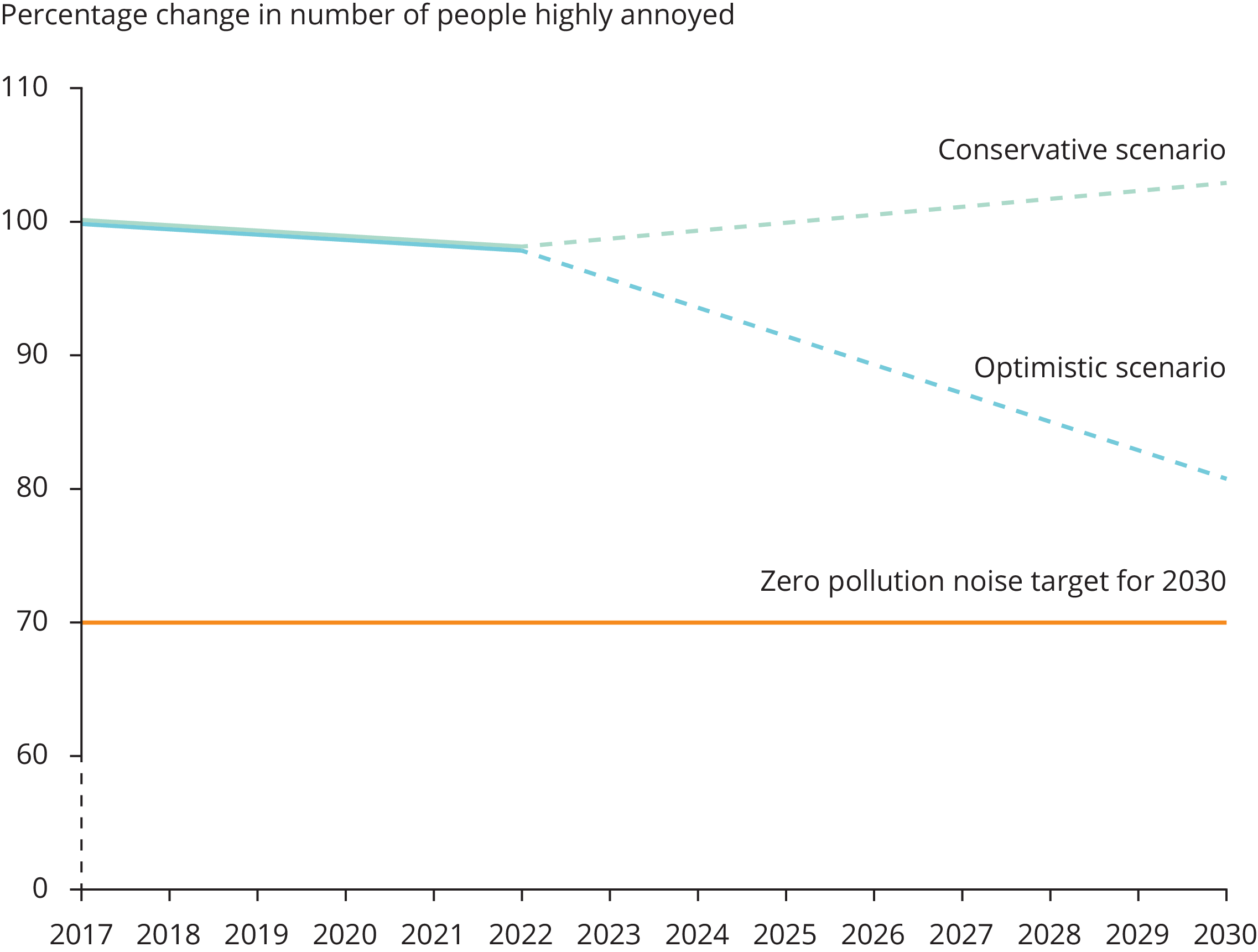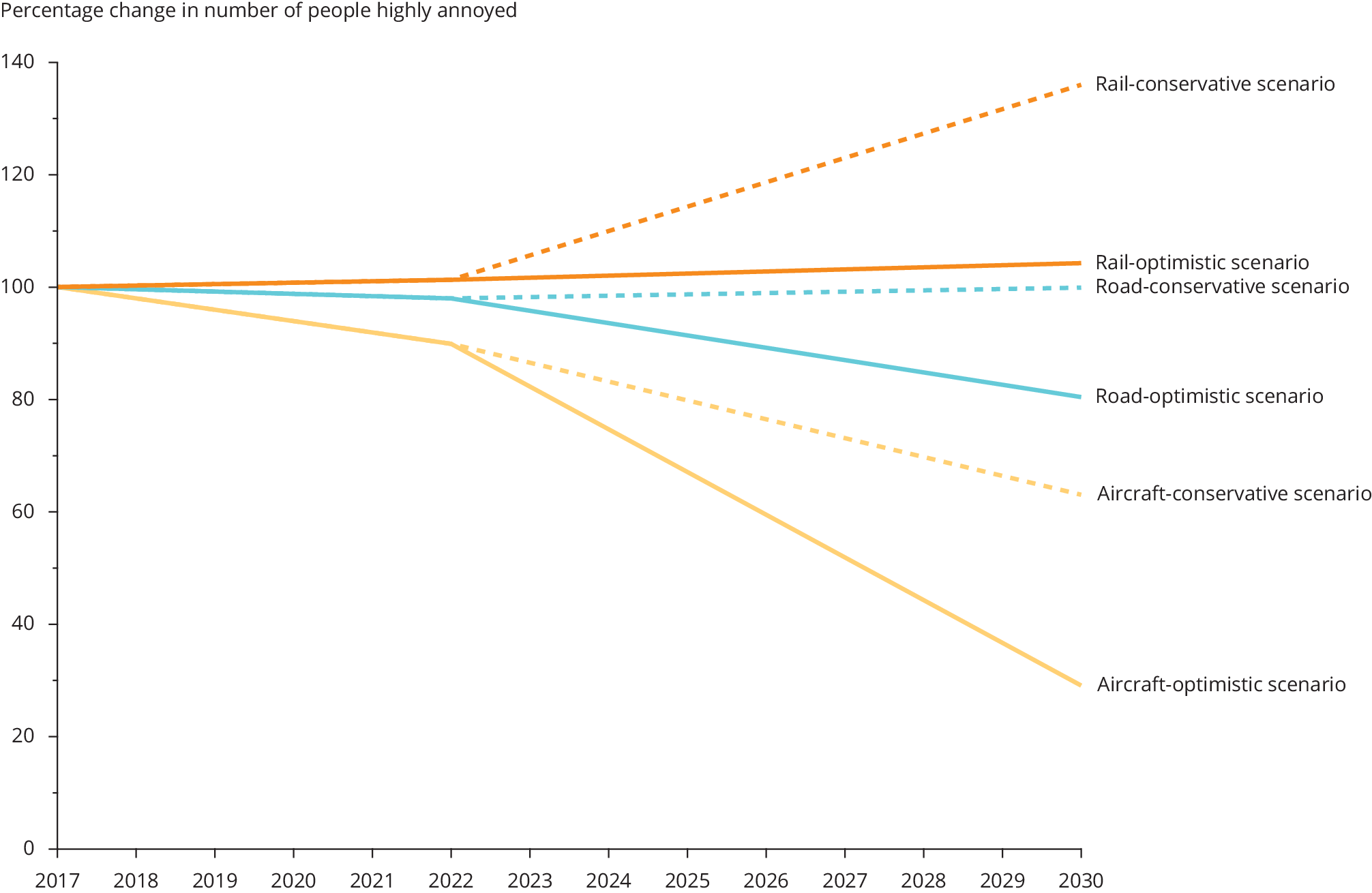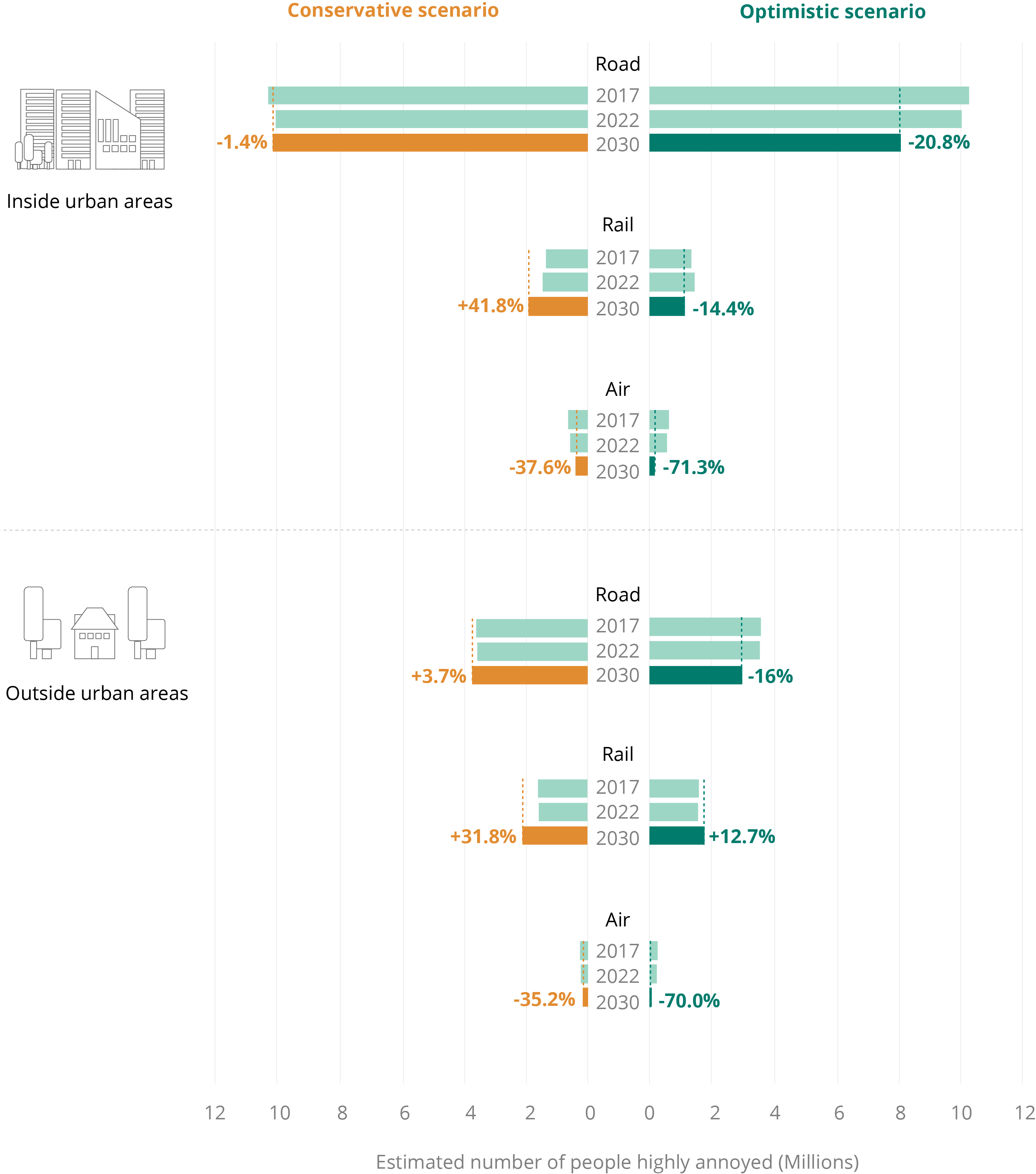Exploring scenarios for transport noise to 2030 — can the zero pollution action plan noise target be met?
Exposure to environmental noise is a widespread problem across Europe. Living in an area affected by transport noise is associated with poorer health, well-being and quality of life (WHO Europe, 2018). In 2017, about 18 million people in the EU were suffering from long-term high annoyance due to transport noise from road, rail and aircraft sources (EEA, 2022). It is estimated that this value has not decreased significantly since 2017.
One of the headline targets of the zero pollution action plan is to reduce the number of people chronically disturbed by transport noise by 30% by 2030 compared with 2017 (see Box 1). To achieve this, the number of people highly annoyed would need to be reduced by 5.3 million compared with the reference year of 2017. This is likely to be particularly challenging given that the overall number of people exposed to harmful levels of noise has remained stable over the last decade (EEA, 2020).
In 2021, the European Commission adopted an action plan ‘towards zero pollution for air, water and soil’ under the European Green Deal.
Given the negative impact of noise on human health and the large number of people affected, reducing environmental noise is a key target under the zero pollution action plan. Specifically, the aim is to reduce by 2030 the number of people chronically disturbed by noise from transport by 30% compared with 2017. To meet this objective, the European Commission has identified the need to:
- monitor progress towards achieving a 30% reduction in the number of people chronically disturbed by noise by 2030;
- improve the noise-related regulatory framework on tyres, road vehicles, railways and aircraft at the EU level, and also at the international level;
- review progress in 2022 and consider if there is a need to set noise reduction targets at the EU level in the Environmental Noise Directive (END);
- improve the integration of noise action plans into sustainable urban mobility plans, benefiting from an extension of clean public transport and active mobility.
In this assessment, we measure progress towards the noise target by assessing changes in the number of people highly annoyed by noise from road, rail and aircraft at EU level. High annoyance is based on the exposure-response functions outlined in the WHO environmental noise guidelines (WHO Europe, 2018) and reported data under the END on the number of people exposed to annual average noise levels of 55dB or higher during the day-evening-night period (Lden).
This briefing assesses whether or not the zero pollution target on noise can be met by 2030. To answer this question, the numbers of people highly annoyed by transport noise are projected under two scenarios, one conservative (less ambitious) and one optimistic. The conservative scenario assumes fulfilment of the legal requirements to reduce noise at source, and the implementation of some non-binding mitigation measures. The optimistic scenario assumes implementation of a set of more ambitious noise mitigation measures that go beyond current regulations.
Figure 1 gives an overview of the measures included in the conservative and the optimistic scenarios. Different measures are included depending on the noise source and the type of area. In both scenarios, projections of population growth and transport activity are considered in combination with implementation of the measures. The full findings and methodology are described in the European Topic Centre on Human Health and the Environment report Projected health impacts from transportation noise — Exploring two scenarios for 2030 (ETC/HE, 2022).

Note: In addition to measure implementation, all scenarios have considered projected population growth and transport activity change. These may outweigh the benefits of the measures considered.
Source: ETC/EH (2022).
The results of this assessment suggest that there are no prospects of achieving a 30% decrease in the number of people chronically disturbed by transport noise by 2030, even with the implementation of a substantial number of noise mitigation measures (see Figure 2). The optimistic scenario suggests that a reduction of only about 19% in the number of people chronically disturbed by transport noise could be achieved. In contrast, under the conservative scenario, the number of people affected by noise could even increase by 3%. This is because the projected growth in population and transport outweighs the benefits of implementing the measures outlined in the conservative scenario.

Notes: High annoyance is based on functions outlined in the World Health Organization environmental noise guidelines (WHO Europe, 2018) and the number of people exposed to noise levels above 55dB during the day-evening-night period (Lden) because of road, rail and aircraft noise in areas covered by the Environmental Noise Directive.
The projections are based on different hypotheses, assumptions and approximations, each of which has associated uncertainties. The projections assume uniform implementation of the measures in all countries. The potential for reduction in each country depends on how many actions/measures have already been implemented. A decrease in noise levels due to the noise reduction measures is assumed to result in an annoyance decrease of at least that predicted by the WHO exposure-response relationship.
Source: ETC/EH (2022).
Click here for different chart formats and data
Road, rail and aircraft noise — what’s possible for each of these sources?
Although the zero pollution target is unlikely to be reached for all sources of transport noise combined, projections differ for rail, road and aircraft. Figure 3 shows the projected percentage change from 2017 to 2030 in the number of people highly annoyed by noise from the three transport sources. Based on the scenarios modelled:
- The number of people highly annoyed by rail noise is projected to increase in both scenarios, and by up to 36% under the conservative scenario.
- The number of people highly annoyed by road traffic noise is projected to remain the same under the conservative scenario or decrease by up to 20% under the optimistic scenario.
- The number of people highly annoyed by aircraft noise is projected to decrease significantly, by up to 71% under the optimistic scenario.

Notes: High annoyance is based on functions outlined in the World Health Organization environmental noise guidelines (WHO Europe, 2018) and the number of people exposed to noise levels above 55dB during the day-evening-night period (Lden) because of road, rail and aircraft noise in areas covered by the Environmental Noise Directive.
The projections are based on different hypotheses, assumptions and approximations, each of which has associated uncertainties. The projections assume uniform implementation of the measures in all countries. The potential for reduction in each country depends on how many actions/measures have already been implemented. A decrease in noise levels due to the noise reduction measures is assumed to result in an annoyance decrease of at least that predicted by the WHO exposure-response relationship.
Source: ETC/EH (2022).
Click here for different chart formats and data
The increase in rail transport is predicted to be much larger than that predicted for road and aircraft traffic. This would lead to increased noise levels in the areas affected and outweigh the benefits of a silent brake policy and the other measures considered. It is therefore unlikely that a decrease in the number of people exposed to rail noise will be achieved by 2030.
A significant reduction of 37% in the number of people highly annoyed by aircraft noise could be achieved under a conservative scenario entailing the progressive uptake of quieter aircraft, combined with improved landing and take-off procedures, to better avoid populated areas. Under an optimistic scenario with additional measures, including night curfews, a fall of up to 71% in the number of people highly annoyed by aircraft noise could be achieved.
The number of people highly annoyed by road traffic noise could be reduced by up to 19% by implementing a combination of measures, including by increasing the proportion of electric vehicles in the fleet to 50% in cities, reducing speed limits, imposing stricter noise emission regulations for vehicles, and increasing the application of low-noise asphalts and noise barriers. However, the implementation of fewer measures under a conservative scenario is not expected to reduce the number of people highly annoyed by road traffic noise.
The main obstacle to reaching the zero pollution target is the large number of people exposed to road traffic noise, with road traffic being by far the most prevalent source of noise. In 2017, more than 14 million people were highly annoyed by road traffic noise, compared with 2.5 million for rail noise and 1 million for aircraft noise. This suggests that increased efforts need to be made to reduce the number of people highly annoyed by road traffic noise in the EU. Although the scale of the impacts of rail noise is much less than that of road traffic noise, increased efforts also need to be made to outweigh the negative health impacts resulting from increased rail activity.
As shown in Figure 4, noise exposure differs between urban and rural areas (outside urban areas). Urban areas have a higher population density and are also more affected by noise pollution because of dense transport infrastructure and high demand for mobility. This means that significantly higher numbers of people are exposed to harmful noise levels in urban areas than in rural areas. The outlooks in terms of noise for 2030 also differ for urban areas and rural areas.
However, the choice of measures to mitigate noise is much broader for cities than for rural areas, especially for road traffic. Under the optimistic scenario, the number of people highly annoyed by noise in cities could be cut by 2 million through the implementation of a set of measures that includes increasing the proportion of electric vehicles to 50%, reducing speed limits, implementing noise emission regulations for vehicles, and extending the use of low-noise asphalts and noise barriers. The choice of measures that could be applied outside cities is more limited and, therefore, cutting the number of people highly annoyed by noise from roads is more challenging in these areas. As shown in Figure 4, under the conservative scenario, the number of people highly annoyed by road noise could increase by 4% outside urban areas if no additional measures are implemented.
A similar pattern is seen for rail and aircraft noise. The optimistic scenario suggests that there is greater potential to cut the number of people highly annoyed by rail and aircraft noise in cities than in rural areas.

Notes: High annoyance is based on functions outlined in the World Health Organization environmental noise guidelines (WHO Europe, 2018) and number of people exposed to noise levels above 55dB during the day-evening-night period (Lden) because of road, rail and aircraft noise in areas covered by the Environmental Noise Directive (END). The 2017 data were reported to the EEA under the END, while the data for 2022 and 2030 are projections based on modelling.
The projections are based on different hypotheses, assumptions and approximations, each of which has associated uncertainties. The projections assume uniform implementation of the measures in all countries. The potential for reduction in each country depends on how many actions/measures have already been implemented. A decrease in noise levels due to the noise reduction measures is assumed to result in an annoyance decrease of at least that predicted by the WHO exposure-response relationship.
Source: ETC/EH (2022).
How could the target be achieved?
To achieve the objective of the zero pollution action plan, there is a need to invest in noise reduction measures that benefit the maximum number of people. While it is important to reduce noise in areas where levels are very high, i.e. above 60-65dB during the day-evening-night period (Lden), because of the increased risk to health, a large share of the population is exposed to noise levels below 60dB and this accounts for the bulk of the burden of disease due to transport noise. According to a recent study on national noise limits, the majority of countries’ limit values are considerably higher than the Environmental Noise Directive (END) reporting threshold of 55dB Lden and are beyond the limits recommended by WHO (Peeters and Nusselder, 2019).
Figure 5 shows the number of people projected to be highly annoyed by noise levels in 2030 divided into five bands starting from 55dB Lden up to 75dB Lden or above. An additional noise band shows the number of people predicted to be highly annoyed at levels below 55dB Lden, that is, at levels considered harmful to health by the WHO but not reported under the END. Under both scenarios, the majority of people projected to suffer long-term high annoyance due to noise from transport in 2030 will be exposed to noise levels below 60dB Lden.
This suggests that, to achieve the zero pollution target, noise mitigation measures should be selected for their potential not only to reduce noise (in decibels), but also to reduce the number of people exposed to harmful levels of noise. Upstream measures that regulate noise sources benefit many people, whereas local measures, such as the placement of a noise barrier, benefit only the people in a localised area. Measures found to affect a large number of people include:
- reducing noise emissions from vehicles through regulation;
- reducing speed limits for motor vehicles in cities;
- maintaining and providing rail grinding for railways;
- improving aircraft landing and take-off procedures to better avoid populated areas;
- using quieter aircraft.
To significantly cut the number of people exposed to harmful levels of noise, a combination of measures is needed, including better urban and transport planning, and significant reductions in road traffic in cites. To increase the impact of transport noise mitigation measures while optimising costs and efforts, combined strategies and policies could be designed for mitigating noise together with other environmental hazards linked to transport (EEA, 2020). In addition to this, new EU regulations tackling noise at source and setting out obligations to act upon critical levels could help to reduce the number of people affected by noise. For instance, a binding obligation to use quiet tyres by 2030 could reduce the number of people affected by noise by approximately an additional 9% in the conservative scenario and an additional 5% in the optimistic scenario.
There is potential for the impact of rail noise to increase in the coming years as a result of more rail activity, new rail infrastructure and faster trains. Therefore, it is important that a large number of rail noise mitigation measures be put in place. In terms of aircraft noise, even if the number of people highly annoyed is reduced as much as the scenarios project, a very high number of people will still be exposed to levels of aircraft noise considered harmful to health by the WHO (see Figure 5). Therefore, measures to reduce the number of people exposed to noise levels below 45-55dB will have the largest impact on reducing the health burden of aircraft noise.

Note: High annoyance is based on functions outlined in the World Health Organization environmental noise guidelines (WHO Europe, 2018) and the number of people exposed to noise levels above 55dB during the day-evening-night period (Lden) because of road, rail and aircraft noise in areas covered by the Environmental Noise Directive (END). Levels above the END reporting threshold were divided into five bands (55-59dB, 60-64dB, 65-69dB, 70-74dB and ≥75dB). Levels below the END reporting threshold were extrapolated based on the WHO-recommended levels of 53dB Lden for road traffic, 54dB Lden for rail traffic and 45dB Lden for air traffic.
Source: ETC/EH (2022).
Click here for different chart formats and data
Case studies
The case studies listed below present examples of good practice in cities and countries in reducing noise pollution from transport and could be useful for authorities seeking to reduce the health impacts of transport noise.
References
EEA, 2020, Environmental noise in Europe — 2020, EEA Report No 22/2019, European Environment Agency.
EEA, 2022, ‘Health impacts of exposure to noise from transport’, European Environment Agency (https://www.eea.europa.eu/ims/health-impacts-of-exposure-to-1) accessed 8 August 2022.
ETC/HE, 2022, Projected health impacts from transportation noise – Exploring two scenarios for 2030, ETC/HE Report 2022/5, European Topic Centre on Human Health and the Environment (https://www.eionet.europa.eu/etcs/etc-he/products/etc-he-products/etc-he-reports/etc-he-report-2022-5-projected-health-impacts-from-transportation-noise-2013-exploring-two-scenarios-for-2030) accessed 22 June 2022.
Peeters, B. and Nusselder, R., 2019, Overview of critical noise values in the European Region, Report No M+P.BAFU.19.01.1, European Network of the Heads of Environmental Protection Agencies.
WHO Europe, 2018, Environmental noise guidelines for the European region, World Health Organization Regional Office for Europe, Copenhagen (https://www.who.int/europe/publications/i/item/9789289053563) accessed 5 May 2022.
Identifiers
Briefing no. 13/2022
Title: Outlook to 2030 - can the number of people affected by transport noise be cut by 30%?
EN HTML: TH-AM-22-016-EN-Q - ISBN: 978-92-9480-496-9 - ISSN: 2467-3196 - doi: 10.2800/985502
EN PDF: TH-AM-22-016-EN-N - ISBN: 978-92-9480-495-2 - ISSN: 2467-3196 - doi: 10.2800/077042





Document Actions
Share with others